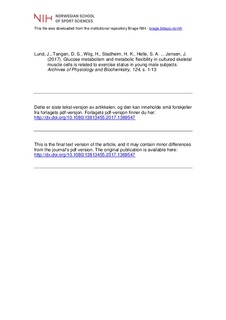| dc.contributor.author | Lund, Jenny | |
| dc.contributor.author | Tangen, Daniel S. | |
| dc.contributor.author | Wiig, Håvard | |
| dc.contributor.author | Stadheim, Hans Kristian | |
| dc.contributor.author | Siw, Anette Helle | |
| dc.contributor.author | Birk, Jesper B. | |
| dc.contributor.author | Ingemann-Hansen, Thorsten | |
| dc.contributor.author | Rustan, Arild | |
| dc.contributor.author | Thoresen, G. Hege | |
| dc.contributor.author | Wojtaszewski, Jørgen F.P. | |
| dc.contributor.author | Kase, Eili Tranheim | |
| dc.contributor.author | Jensen, Jørgen | |
| dc.date.accessioned | 2018-09-20T10:55:44Z | |
| dc.date.available | 2018-09-20T10:55:44Z | |
| dc.date.created | 2018-01-08T13:12:32Z | |
| dc.date.issued | 2017 | |
| dc.identifier.citation | Archives of Physiology and Biochemistry. 2017, 124, 119-130. | nb_NO |
| dc.identifier.issn | 1381-3455 | |
| dc.identifier.uri | http://hdl.handle.net/11250/2563630 | |
| dc.description | I Brage finner du siste tekst-versjon av artikkelen, og den kan inneholde ubetydelige forskjeller fra forlagets pdf-versjon. Forlagets pdf-versjon finner du på tandfonline.com / In Brage you'll find the final text version of the article, and it may contain insignificant differences from the journal's pdf version. The definitive version is available at tandfonline.com | nb_NO |
| dc.description.abstract | We hypothesised that skeletal muscles of healthy young people have a large variation in oxidative capacity and fibre-type composition, and aimed therefore to investigate glucose metabolism in biopsies and myotubes isolated from musculus vastus lateralis from healthy males with varying degrees of maximal oxygen uptake. Trained and intermediary trained subjects showed higher carbohydrate oxidation in vivo. Fibre-type distribution in biopsies and myotubes did not differ between groups. There was no correlation between fibre-type I expression in biopsies and myotubes. Myotubes from trained had higher deoxyglucose accumulation and fractional glucose oxidation (glucose oxidation relative to glucose uptake), and were also more sensitive to the suppressive action of acutely added oleic acid to the cells. Despite lack of correlation of fibre types between skeletal muscle biopsies and cultured cells, myotubes from trained subjects retained some of their phenotypes in vitro with respect to enhanced glucose metabolism and metabolic flexibility. | |
| dc.language.iso | eng | nb_NO |
| dc.subject | training condition | nb_NO |
| dc.subject | myotubes | nb_NO |
| dc.subject | glucose | nb_NO |
| dc.subject | suppression | nb_NO |
| dc.subject | oxidation | nb_NO |
| dc.title | Glucose metabolism and metabolic flexibility in cultured skeletal muscle cells is related to exercise status in young male subjects | nb_NO |
| dc.title.alternative | Glucose metabolism and metabolic flexibility in cultured skeletal muscle cells is related to exercise status in young male subjects | nb_NO |
| dc.type | Journal article | nb_NO |
| dc.type | Peer reviewed | nb_NO |
| dc.description.version | acceptedVersion | nb_NO |
| dc.description.version | publishedVersion | nb_NO |
| dc.source.pagenumber | 119-130 | nb_NO |
| dc.source.volume | 124 | nb_NO |
| dc.source.journal | Archives of Physiology and Biochemistry | nb_NO |
| dc.source.issue | 2 | nb_NO |
| dc.identifier.doi | 10.1080/13813455.2017.1369547 | |
| dc.identifier.cristin | 1537707 | |
| dc.description.localcode | Seksjon for fysisk prestesjonsevne | nb_NO |
| cristin.unitcode | 150,31,0,0 | |
| cristin.unitname | Seksjon for fysisk prestasjonsevne | |
| cristin.ispublished | true | |
| cristin.fulltext | original | |
| cristin.fulltext | postprint | |
| cristin.qualitycode | 1 | |
